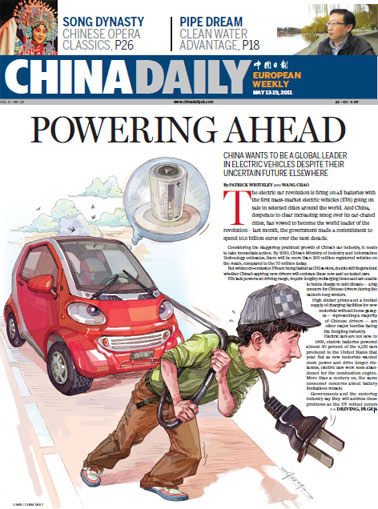Society
Severe drought saps power output
Updated: 2011-05-18 07:51
By Wang Qian and Guo Rui (China Daily)
BEIJING - A severe drought along the Yangtze River is drying up electricity output at some big dams in the southern parts of China, including the Three Gorges Dam, the world's largest hydropower project.
 |
|
A boat rests on the riverbed in a section of the Hanjiang River, a major branch of the Yangtze River, in Yunxian county of Hubei province on Sunday. Cao Zhonghong / Xinhua |
Since Sunday, water levels at about 1,392 water reservoirs in Hubei province have been too low to operate, and the water level of the Three Gorges Dam fell below 156 meters - the required level for full power generation - according to the latest statistics from the Hubei water resources bureau.
"The output of electricity decreased a little because the water flowing through the dam is less than usual," Wang Hai, director of the transport division of the Three Gorges Corporation told China Daily.
| ||||
According to Central China Grid Co Ltd under the State Grid, the country will face great pressure to meet the demand for electricity in Central China this summer.
Statistics from the National Development and Reform Commission showed the electricity output of most major hydropower stations in Hubei has decreased sharply in April, except at the Three Gorges and Gezhou dams.
The power output of Gaobazhou and Geheyan hydropower plants even dropped by 50 percent in April, the statistics said.
In order to relief the drought, sluice gates at the Three Gorges Dam have been partially opened to allow more water to flow downstream, the second time the dam increased water discharges in May, Wang said.
The dam's power output is expected to reach 88 billion kWh in 2011, about 4 billion more than the output in 2010.
Some central and southwestern Chinese provinces have already seen signs of power shortage before the summer peak, because many hydropower plants are wilting after a lack of rainfall.
Officials in Changsha, capital of Hunan province, held an emergency conference on May 13 to encourage its residents to save energy for the power shortage.
Since March, limited electricity supply plans such as power cuts have been carried out in Zhejiang, Jiangsu, Hebei, Hubei, Jiangxi and Guangdong provinces to relieve pressure on the energy supply.
The National Energy Administration has warned that power shortages could be severe until June, with the electricity demand reaching 2,200 billion kWh, a year-on-year increase of 11 percent, posing challenges to the country's power suppliers.
Hydropower serves as the second biggest energy supplier in China with more than 45,000 hydropower plants built as of 2010, producing more than 662 billion kWh annually, a report on China's hydropower development released by China Huadian Corporation showed.
Although the seasonal drought has decreased electricity output, experts felt confident about hydropower and said more plants should be built.
Han Xiaoping, CEO of China Energy Net, a major energy information provider, told China Daily on Tuesday that China should speed up the construction of hydropower stations in the rainy southwestern areas to avoid the seasonal water shortage.
Chang Xiaolin, a professor in the College of Water Resources and Hydroelectric Engineering of the Wuhan University, told China Daily that hydropower is seasonal, so people should not panic about the temporary power shortage, which will end when flooding season comes, generally from June to August.
From May 20 to 24, middle to heavy rains are expected to fall in the central and southern China regions, the China Meteorological Administration predicted on Tuesday.
E-paper

Green works
Wuxi becomes 'test case' for facing country's environmental challenges
Preview of the coming issue
The global rise of Chinese brands
China-EU trade on solid ground
Specials

The song dynasty
There are MORE THAN 300 types of Chinese operas but two POPULAR varieties are major standouts

Cut above the rest
One of the world's oldest surgeons has performed more than 14,000 operations

From the ground up
Architect of Guangzhou Opera House has many projects under way, including 2012 Olympics.




